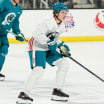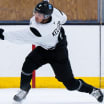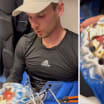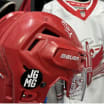The Vitamix whirs, turning a tornado of pear and blueberries and kefir into liquid. It's an experiment of sorts for Kelsie Snow, an attempt at making food for her husband, Chris -- an act she has performed thousands of times over their 15 years together.
Flames executive Snow adjusting to feeding tube in ALS treatment
Assistant GM had surgery this month after setback during clinical trial
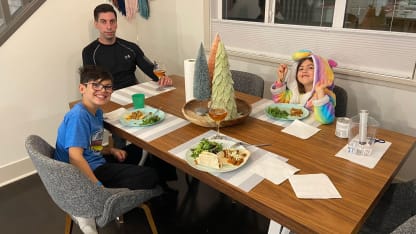
But these days the meals look different for Chris Snow, the assistant general manager of the Calgary Flames who was diagnosed with amyotrophic lateral sclerosis, or ALS, in June 2019. Also known as Lou Gehrig's disease, it affects nerve cells in the brain and spinal cord and causes progressive loss of muscle control, eventually robbing patients of the ability to move, speak and breathe.
On Dec. 1, Snow had surgery to insert a feeding tube after his swallowing mechanism weakened and eating by mouth had come with a fear of choking or aspirating.
"The feeding tube, it's not a big surgery, but it's a big adjustment," Kelsie said. "Maybe mentally more than anything else."
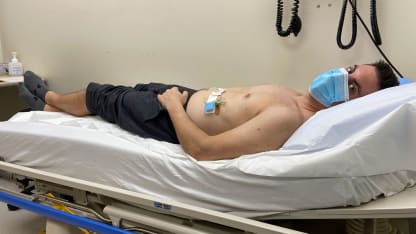
The Snows have formula delivered to their door, liquid that can be attached to the "eating tube," as the family calls it for normalcy. But after a week of that, Kelsie turned toward creating her own blended diet. She has been working on recipes, one with tuna, spinach, chickpeas and chicken broth. On this day, it's a concoction of 80 grams of blueberries, two-thirds of a cup of full-fat plain Greek yogurt, one tablespoon of MCT oil, two tablespoons of almond butter, three-fourths of a cup of unsweetened kefir, and a pear, an effort to make an appetizing-looking meal for someone whose food tends to take on either a brown or green tinge.
This one turns out a beautiful shade of violet.
She pauses for a moment, to measure, to record amounts, to check in with Chris, who is near her in their Calgary kitchen.
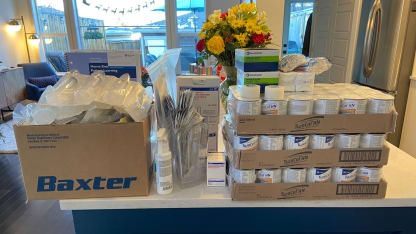
After being diagnosed with ALS in 2019, Snow enrolled in a phase 3 clinical trial at Sunnybrook Health Sciences Centre in Toronto for patients with his familial mutation, SOD1, testing a drug that could be a great step forward for a disease that has no cure. The Snows believed that the drug, tofersen, had allowed Chris to see no changes from symptom onset, when he lost use of his right hand and arm, until April.
But April brought a change, a crushing development for a family that has pinned its hopes on the drug and celebrated the lack of progression after a diagnosis that normally brings death six-to-18 months after symptom onset, especially the particular familial strain that Chris has.

The family was sledding, and Kelsie gathered Chris and one of their kids, 6-year-old Willa, for a picture.
In the photo, Chris's smile was wonky. She took another. It remained the same, a slight dip in one side of a smile that is one of his defining features.
"We didn't know what that meant at that point," Kelsie said. "And then within weeks it just kept getting harder for him to smile, lift his eyebrows, his forehead. Since then we've noticed some atrophy in his cheeks, his lips, things like that."
The nasally voice came in July, when the smile had fully vanished, which prompted Chris to start on voice and message banking, to preserve his ability to speak in his own voice in case it eventually goes fully. Chris has spent hours saying common words and phrases, plus phrases that are unique to him, into a computer, so that the recordings can be used to create a custom digital voice. As Kelsie put it in her blog, kelsiesnowwrites.com, "he would be his own Siri."
It was August when they began noticing the issues with swallowing, another blow.
"It started as what we would call a double swallow," Kelsie said. "Not that he was having a problem swallowing, just it felt like sometimes it wasn't going all the way down, which is a common first issue for ALS patients when they start to have, basically, it's called dysphagia, which is when your swallowing starts to weaken.
"From August until the surgery, it was a pretty hard and fast loss of function, which surprised both of us."
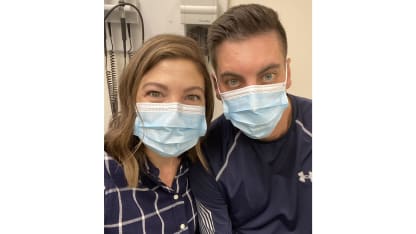
Before the surgery, Snow was spending "literally all day eating, and it was a giant struggle," as Kelsie put it, with more and more foods being added to the list of those that didn't work. It was not only difficult for Chris. It was affecting their entire family, with their 9-year-old son Cohen experiencing panic attacks and nightmares about his father choking and dying.
"That was awful," Kelsie said. "And it was just a lot of work. He was exhausted all the time from trying to eat, from trying to cough up some miniscule piece of something that got stuck in a place in his throat that he couldn't get it out."
The worst day was when the Snows celebrated Thanksgiving in November. Kelsie had prepared a normal Thanksgiving meal for the family and, one stuck bite of roasted carrot in, Chris went into an hour-and-a-half coughing fit to dislodge it, while Cohen got increasingly panicked.
"It was horrible," she said. "That was our lowest point, for sure."
The feeding tube was placed less than a week later.
It's crucial for ALS patients to maintain their weight, and before the surgery Chris needed to have food near him constantly, especially given that he had lost about 10 pounds since March. He was downing large Oreo milkshakes from Dairy Queen and eggs-and-breakfast sausage meals and Venti caramel Frappuccinos from Starbucks every day, anything that he could tolerate swallowing with a high caloric bang-for-his-buck.
Now he can eat for pleasure. There are foods that still work for him -- oysters and lobster, scallops and fatty brisket. He can have a couple of bites and be sated, be content, because he's already downed one of Kelsie's blended meals or a can of formula, which is a more calorie- and mineral-dense version of Ensure.
"That's what's so freeing now, is eating is no longer a job," Kelsie said. "If this feels like it's hard and you don't want to do it, then you stop. Because you don't have to. Eating is only for enjoyment."
They said they believe it's possible that one of the reasons for the issues with smiling and swallowing is that the drug isn't diffusing properly. That would mean that the tofersen isn't getting up to the upper nerve roots that control the face and swallowing mechanisms. To combat that, the Snows now have an inversion table, a piece of equipment that allows Chris to hang upside down for long periods. After his dose on Dec. 11, the plan was for him to go into the inversion table for two hours each day for a couple of days and then an hour each day for the following week. Kelsie said she believes that she has felt more resistance in his lips since the first time Chris used it, and they will take any action with even a chance at helping.
Because the Snows don't know how long this will last, how long Chris will be in this place physically, they are, as always, hoping for the best and planning for the worst. Chris is eating as if he might not be able to eat anything in two months, acting on the cravings and sparing no expense. His breathing and cough remain strong, good signs in the ALS world. He soon will be going to a prosthodontist, who could make Chris a palatal lift appliance, which would push his palate up to help with changes to his speech.
"Certainly for us the big hope and the big fingers crossed is that we can just have a bit of a plateau," Kelsie said. "These last months have been pretty hard. And we're just hoping that we can settle into this for a bit. Forever is the hope."
To contribute to ALS research on behalf of Chris Snow, you can donate directly to the University of Miami's Miller School of Medicine or through the Calgary Flames Foundation. The Flames Foundation announced on Friday that it had donated $200,000 from the #SnowyStrong and #TrickShot4Snowy initiatives to Sunnybrook Health Sciences Centre in Toronto, where it will fund clinical trial research for ALS and the work of Dr. Lorne Zinman, including the trial that Snow has taken part in.
Photos courtesy: Kelsie Snow











